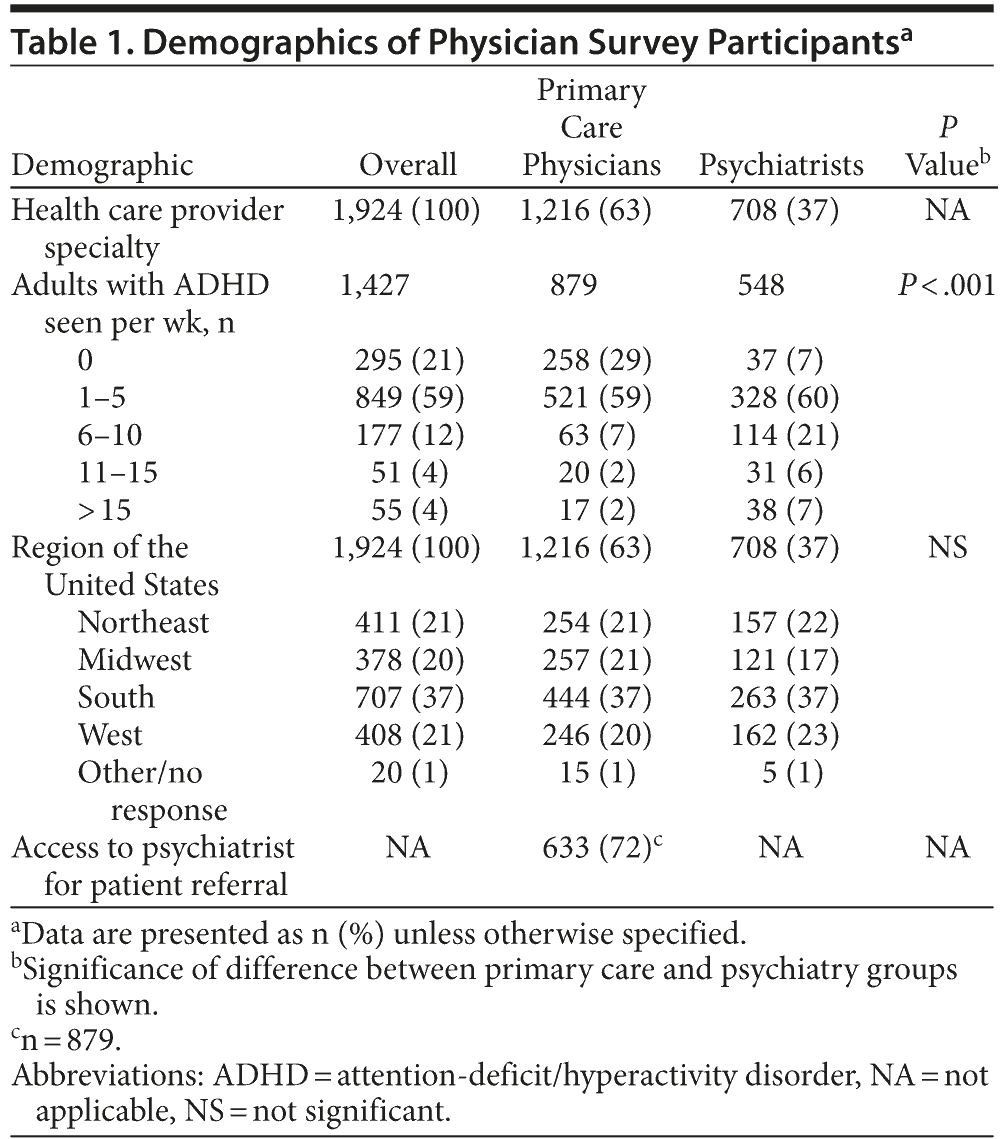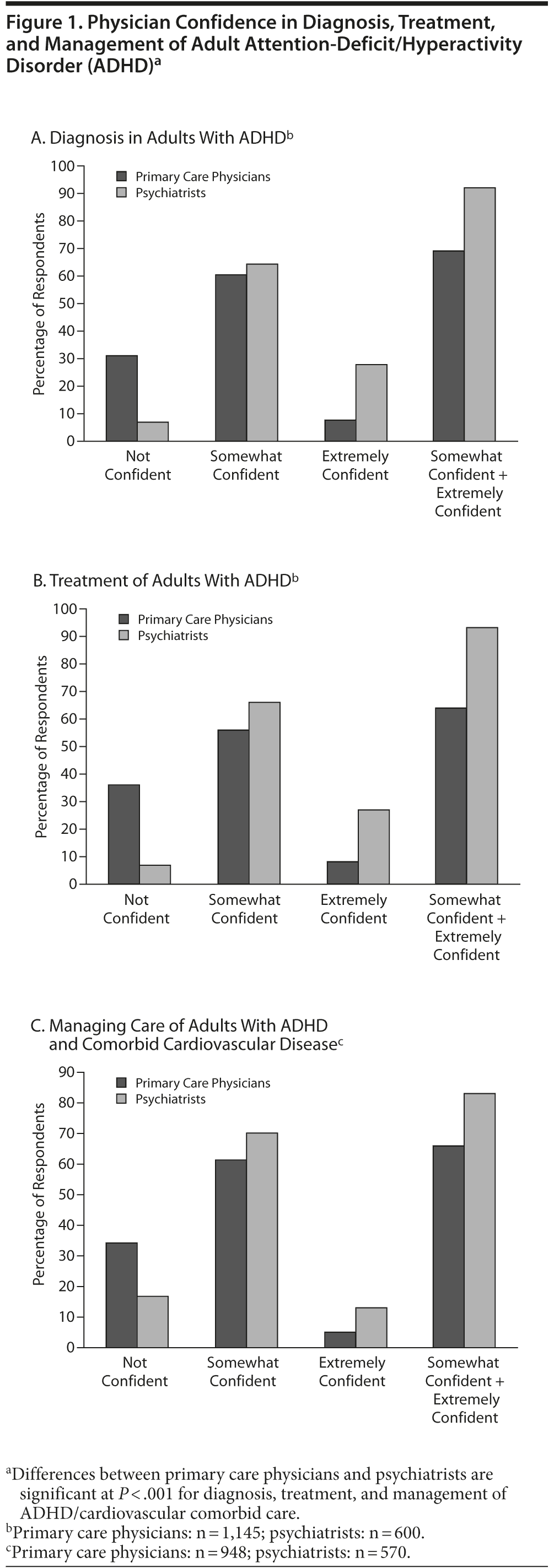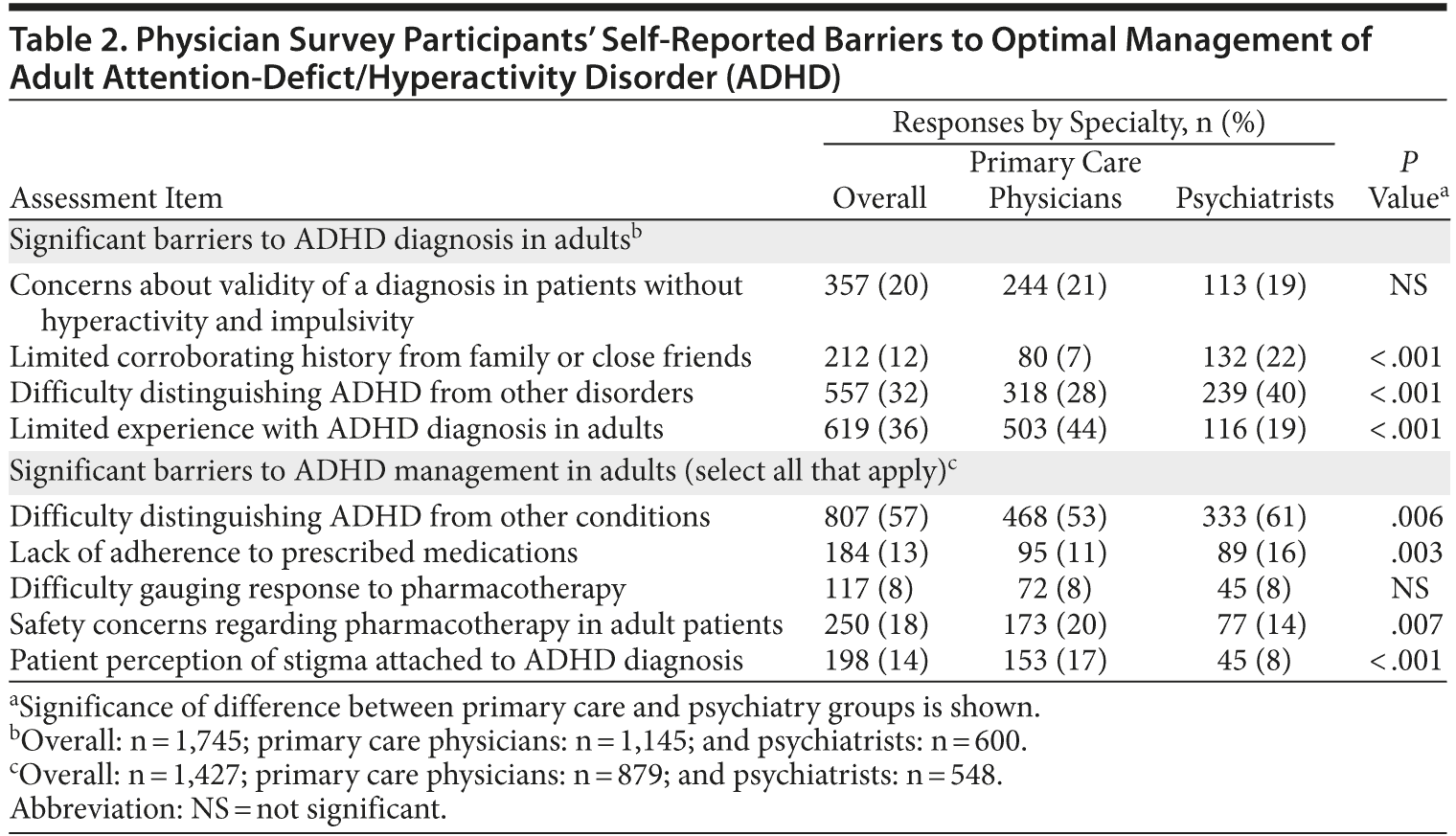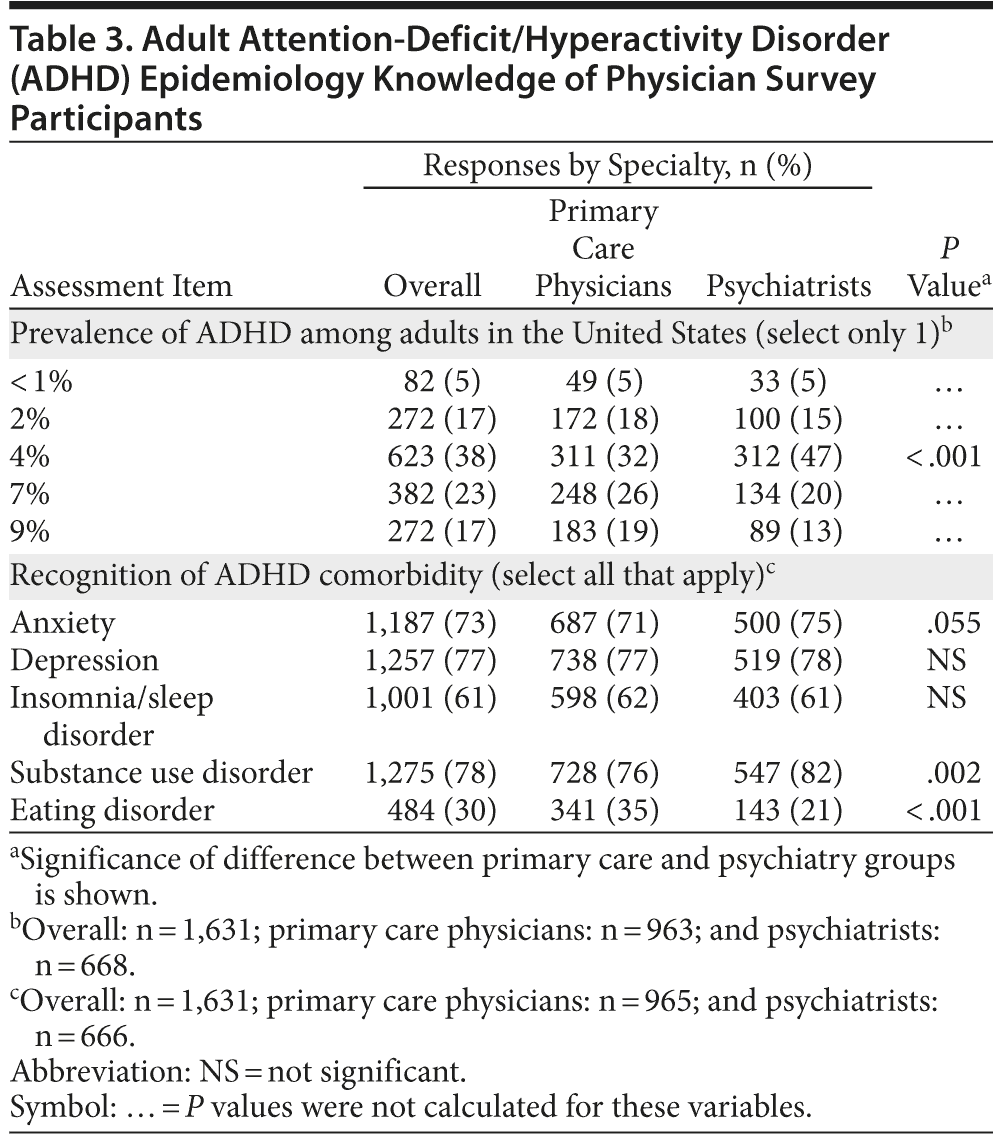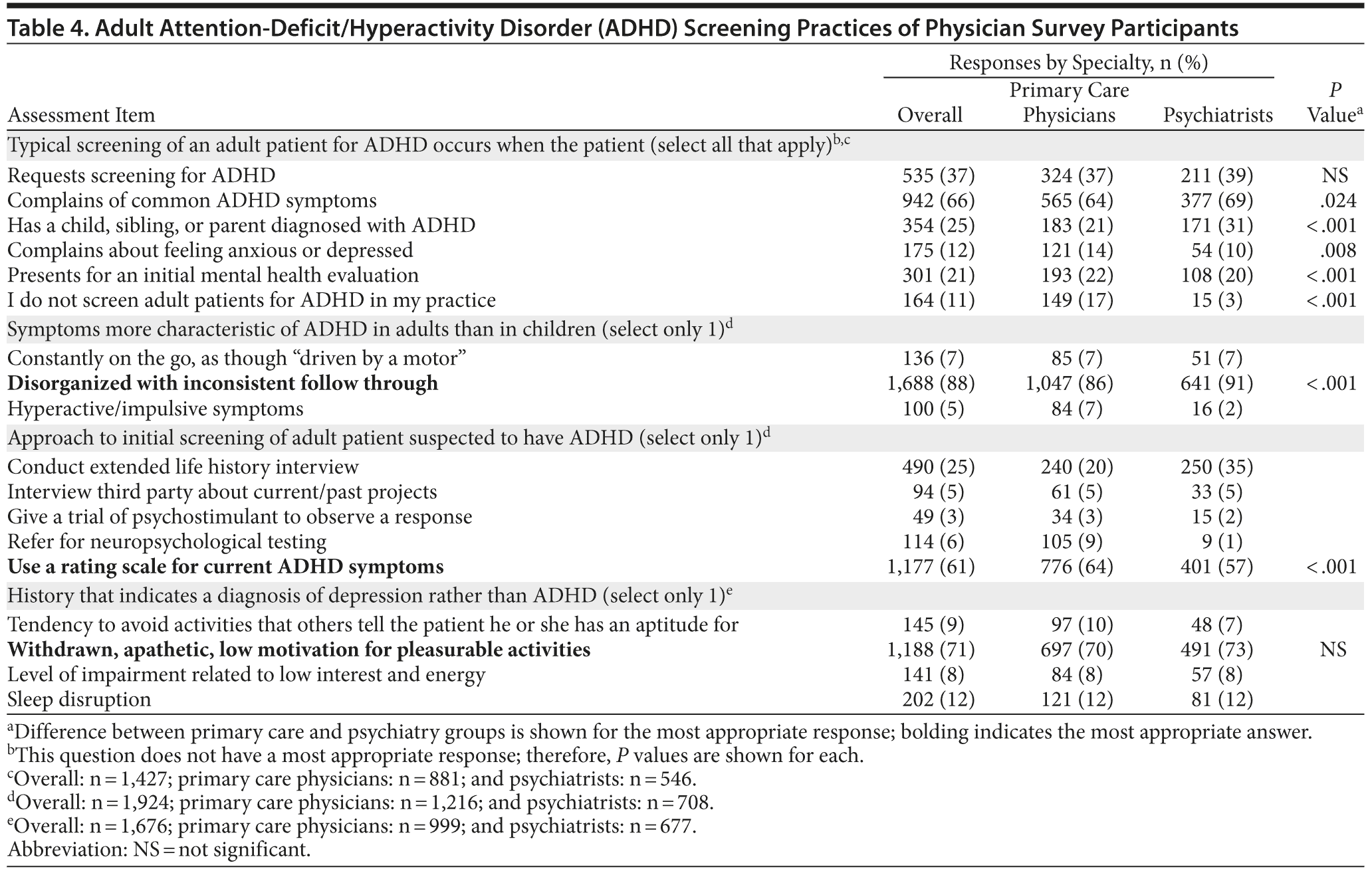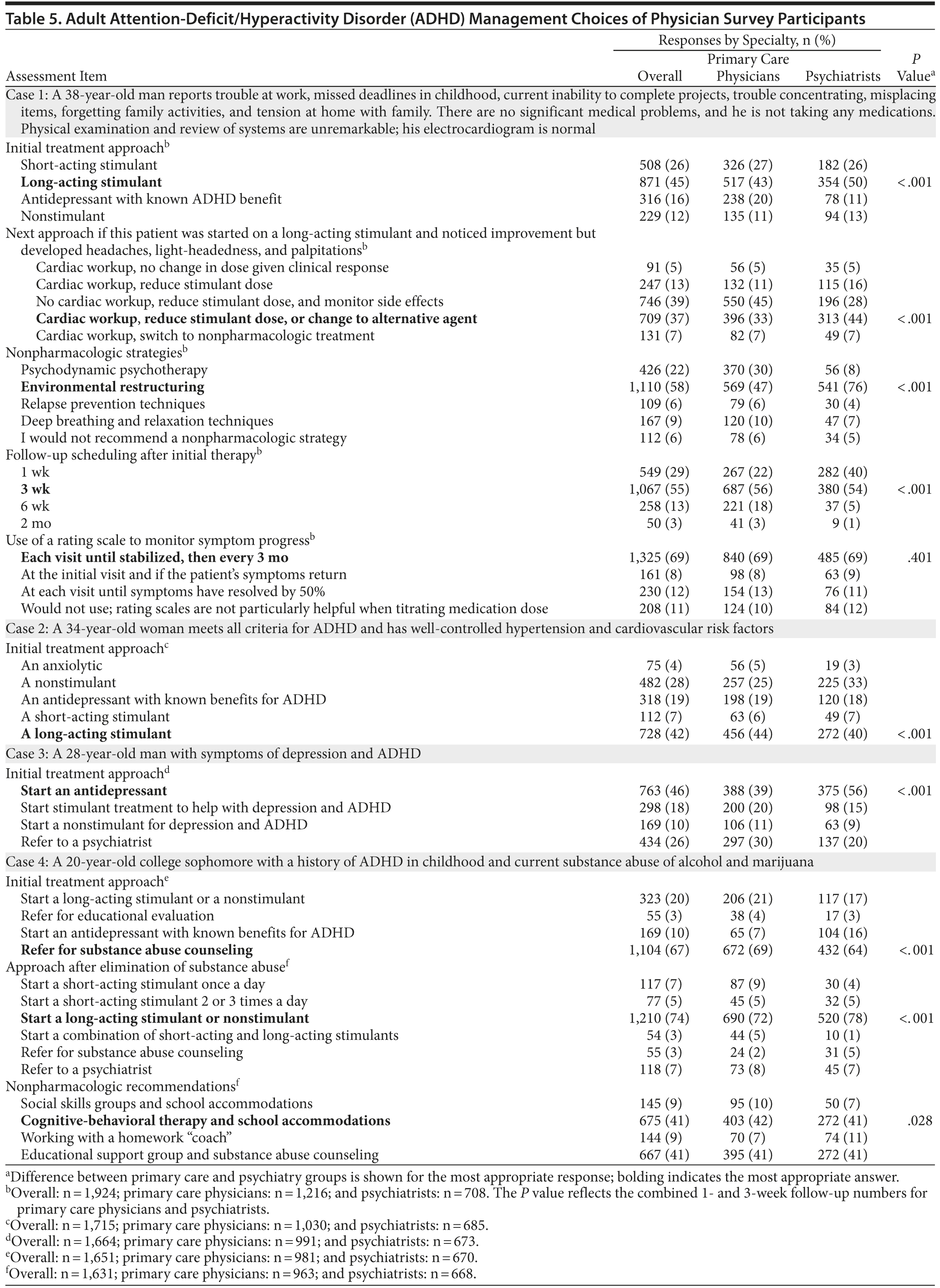Assessment of Physician Practices in Adult Attention-Deficit/Hyperactivity Disorder

ABSTRACT
Objective: Adult attention-deficit/hyperactivity disorder (ADHD) is a common neuropsychiatric disorder, yet only 1 in 10 affected adults receives treatment. The study objective was to assess gaps in knowledge and describe current practice patterns of primary care physicians and psychiatrists in the United States in the management of adult patients with ADHD.
Method: Primary care physicians and psychiatrists completed an Internet survey as a needs assessment of customary care related to management of adults with ADHD. Adult clinical case vignettes were followed by practice, confidence, and barrier questions. Survey data were collected from April 15, 2010, to August 22, 2010, and were deidentified and analyzed in aggregate to maintain confidentiality. χ2 and t tests were used to compare responses of primary care physicians with those of psychiatrists.
Results: The survey was completed by 1,924 physicians: 1,216 primary care physicians and 708 psychiatrists. Fewer primary care physicians than psychiatrists were “extremely confident” in diagnosis (8% vs 28%, respectively, P < .001) and treatment (8% vs 27%, respectively, P < .001). Limited experience with ADHD diagnosis was more of a barrier in primary care than in psychiatry (44% vs 19%, respectively, P < .001). Mean scores on 12 evidence-based questions were lower for primary care physicians than for psychiatrists (6.1 vs 6.8 correct, respectively, P < .001). Awareness of adult ADHD prevalence was lower among primary care physicians than among psychiatrists (32% vs 47% correct, respectively, P < .001). Fewer primary care physicians than psychiatrists recognized comorbid substance use disorder (76% vs 82%, respectively, P = .002), but more primary care physicians than psychiatrists recognized eating disorders (35% vs 21%, respectively, P < .001).
Conclusions: The self-assessment survey results indicate physician practices in primary care and psychiatry differ and show areas in which further education will be useful to improve care for adults with ADHD.
Prim Care Companion CNS Disord 2012;14(4):doi:10.4088/PCC.11m01312
© Copyright 2012 Physicians Postgraduate Press, Inc.
Submitted: October 28, 2011; accepted February 29, 2012.
Published online: August 2, 2012.
Corresponding author: David W. Goodman, MD, Department of Psychiatry and Behavioral Sciences, Johns Hopkins University School of Medicine at Green Spring Station, 10751 Falls Road, St 306, Baltimore, MD 21093 ([email protected]).
Assessment and improvement of physician performance in adult attention-deficit/hyperactivity disorder (ADHD) management is important, as the disorder has a prevalence rate of 4.4%, making it a common neuropsychiatric disorder in adults in the United States, second only to major depression.1 ADHD is marked by poor regulation of attention and behavior, with a broad impact on life functioning related to risks for educational and occupational underachievement, motor vehicle accidents, substance abuse, social dysfunction, and legal difficulties.2-6 The National Comorbidity Survey Replication, conducted from 2001 to 2003, found that only 1 in 10 adults identified as having ADHD were being treated for their ADHD,1 even though 45% had been in treatment for other mental health disorders during the previous year. This finding suggests that mental health professionals are often overlooking ADHD in their clinical evaluations.
The current, most widely used system for identification of ADHD in adults is found in the DSM-IV-TR, which uses criteria developed for male children.7 Emerging guidelines developed for adults are based on expert opinion in Canada (Canadian ADHD Resources Alliance),8 the United Kingdom (National Institute for Health and Clinical Excellence),9 and Europe (European Network).10 However, US physicians lack guideline support for adult ADHD management. Until recently, physicians have had little basis for learning how to diagnose and treat ADHD in adults.
In April 2010, we created an Internet survey as a needs assessment of customary care related to management of adults with ADHD. The survey included questions related to “simple” adult ADHD, ADHD in adults with psychiatric comorbidity, and ADHD in adults with medical comorbidity, all typical of adults seen in primary care. The purpose was to assess gaps in knowledge and describe current practice patterns of primary care physicians (PCPs) and psychiatrists in the United States in the management of adult patients with ADHD.
METHOD
Design
The major survey component was clinical case vignettes of adult patients who were seen in primary care for initial screening and treatment of ADHD (Appendix 1). Previous research demonstrated that clinical case vignettes, when compared with other methods such as patient chart reviews and seeing standardized patients (trained actors who present unannounced to physicians’ clinics), provide a valid, cost-effective, and noninvasive method to measure physician practices.11,12
Participants answered 14 questions related to the case vignettes, selecting multiple-choice answers. Free text response was not permitted. The best answer choices were designated on the basis of available evidence.6-9,13-20 The survey included questions about confidence in ADHD management, barriers to optimal care, and respondent demographics. The survey was reviewed by community-based physicians to improve clarity and relevance to the target audience. Medscape is accredited by the Accreditation Council for Continuing Medical Education (CME) to provide CME for physicians and certified this assessment for 0.25 hours of CME credit.

- Limited experience with adult attention-deficit/hyperactivity disorder (ADHD) diagnosis and treatment is a barrier to adequate care in both primary care and psychiatry practice, and difficulty distinguishing ADHD from other disorders is a significant barrier to ADHD management.
- All patients who present with significant mental health symptoms should be evaluated for ADHD because of the high prevalence rate in the general population and the high rate of comorbid psychiatric disorders (ie, depression, anxiety, and substance use disorders).
- Although awareness of ADHD has grown, further education about adult ADHD will improve patient care by both primary care physicians and psychiatrists.
Participants
The survey was available with free online access on the Medscape Web site from April 15, 2010, through April 15, 2011, for credit as a self-assessment.21 Participants were recruited by e-mailed newsletters to registered members of the health care information site who had previously listed an interest in psychiatry-related CME. Inclusion criteria were free registration at the health care information site as a US physician and completion of the survey as a CME activity. Primary care providers and psychiatrists were selected as the most relevant subgroups of specialists for analysis. To collect participant data, completion of the online survey for CME credit was tracked. All participant response data were deidentified and analyzed in aggregate to maintain the confidentiality. Data included responses from April 15, 2010, through August 22, 2010, from all physician participants in the primary care and psychiatry specialties.
Measurements
All statistical analyses were completed with PASW Statistics 18 (SPSS Inc, Chicago, Illinois). Descriptive statistics were used to summarize demographic characteristics of participants and responses. Chi-square and t tests were used to compare responses according to several variables, including PCPs versus psychiatrists.22 For questions with evidence-based answers, 1 P value is shown to compare samples selecting the appropriate response. For questions with no preferred response or questions that were “select all that apply,” P values show differences between each potential response.
RESULTS
Survey Participant Demographics
Overall, 1,924 US physicians completed the survey for CME credit from April 15, 2010, through August 22, 2010. Of these, 63% (n = 1,216) identified themselves as PCPs and 37% (n = 708) identified themselves as psychiatrists (Table 1). No statistically significant differences among regions were identified; 37% of PCPs and 37% of psychiatrists were from the South, 21% of PCPs and 22% of psychiatrists were from the Northeast, 21% of PCPs and 17% of psychiatrists were from the Midwest, and 20% of PCPs and 23% of psychiatrists were from the West. In clinical practices, 71% of PCPs saw at least 1 adult with ADHD per week, and 59% saw up to 5 per week. Among psychiatrists, 93% saw at least 1 adult with ADHD each week, 60% saw up to 5 per week, and 21% saw up to 10 per week.
Confidence, Barriers, and Knowledge of Adult ADHD
Physician confidence in adult ADHD management differed significantly between specialties (Figure 1A-C). Fewer PCPs than psychiatrists (8% vs 28%, respectively, P < .001) were “extremely confident” in diagnosing an adult with ADHD; far more PCPs than psychiatrists were “not confident” (31% vs 7%, respectively, P < .001). Likewise, fewer PCPs than psychiatrists reported that they were “extremely confident” about treatment (8% vs 27%, respectively, P < .001), and more PCPs than psychiatrists considered themselves “not confident” (36% vs 7%, respectively, P < .001). For managing adult ADHD and comorbid cardiovascular disease, even fewer respondents reported that they were “extremely confident” (5% of PCPs vs 13% of psychiatrists).
The greatest barrier to diagnosis among PCPs was limited experience with ADHD diagnosis in adults (44% for PCPs vs 19% for psychiatrists, P < .001) (Table 2). For psychiatrists, the most often reported barrier was difficulty distinguishing ADHD from other disorders, at 40%. PCPs and psychiatrists reported diagnosis in patients who did not exhibit classic symptoms of hyperactivity and impulsivity as a significant barrier (21% for PCPs vs 19% for psychiatrists, P = not significant). Although more than one-fourth of PCPs (28%) have difficulty distinguishing ADHD from other disorders as a barrier to diagnosis, this was the most frequently reported barrier for ADHD management by both groups (53% for PCPs vs 61% for psychiatrists, P = .006). Other barriers were safety concerns regarding pharmacotherapy, stigma associated with diagnosis, and patient adherence to therapy.
Awareness of adult ADHD prevalence at 4% was lower among PCPs versus psychiatrists (32% vs 47%, respectively, P < .001); most respondents overestimated the prevalence (Table 3). Regarding comorbidities in adults with ADHD, overall, 77% knew that depression is frequent and 73% recognized anxiety, with no significant differences between groups. Fewer PCPs than psychiatrists (76% vs 82%, respectively, P = .002) recognized substance use disorder, and more PCPs than psychiatrists (35% vs 21%, respectively, P < .001) recognized eating disorders.
Management of Adult ADHD
For the 12 questions with evidence-based responses to adult ADHD management, mean ± SD scores of PCPs were lower compared with those of psychiatrists (6.1 ± 2.1 vs 6.8 ± 2.2, respectively, P < .001). Approximately two-thirds of participants screen adults who complain of typical symptoms for ADHD; however, few screen for ADHD in the initial mental health evaluation (22% of PCPs vs 20% of psychiatrists, P < .001) (Table 4). Viewed differently, 80% of psychiatrists were not screening for ADHD in an initial evaluation in which there were presenting symptoms. Few PCPs or psychiatrists reported screening for ADHD when adult patients complained about feeling anxious or depressed (14% for PCPs vs 10% for psychiatrists, P = .008). More PCPs than psychiatrists reported not screening for adult ADHD at all (17% vs 3%, respectively, P < .001). Of those physicians screening for ADHD, most (57% of psychiatrists vs 64% of PCPs, P < .001) used an ADHD rating scale. However, few physicians overall (25%), and fewer PCPs than psychiatrists, conducted an extended interview to ascertain patients’ history (20% of PCPs vs 35% of psychiatrists, P < .001).
The patient in case 1 was a 38-year-old man who met criteria for ADHD, was taking no medications, and had a normal electrocardiogram. Fewer PCPs than psychiatrists chose a long-acting stimulant as initial therapy (43% vs 50%, respectively, P < .001) (Table 5). Approximately a quarter of PCPs and psychiatrists chose an immediate-release, short-acting stimulant as initial therapy (27% vs 26%, respectively, P = not significant). As follow-up care, the majority of physicians, but fewer PCPs than psychiatrists, reported that they would schedule an appointment within 3 weeks of initiating therapy (78% vs 94%, respectively, P < .001, combined 1-week and 3-week follow-up). Further, overall, 69% would use a rating scale to monitor symptomatic response at each visit until the patient was stabilized on medication and then would evaluate the patient every 3 months thereafter. Only 11% of respondents overall opted not to use a rating scale to titrate stimulant dose.
The patient in case 1 had improvement of symptoms but new-onset headache, light-headedness, and palpitations. Fewer PCPs than psychiatrists selected performing a cardiac workup, reducing the stimulant dose, or switching to an alternative agent (33% vs 44%, respectively, P < .001). More PCPs than psychiatrists selected no cardiac workup, reduce the stimulant dose, and monitor side effects (45% vs 28%, respectively) (Table 5). Only 7% of both groups elected to switch to pharmacologic treatment. As a nonpharmacologic strategy for this patient, fewer PCPs than psychiatrists chose environmental restructuring (47% vs 76%, respectively, P < .001), whereas more PCPs than psychiatrists chose psychodynamic psychotherapy (30% vs 8%).
Management of Adult ADHD With Comorbidities
The patient in case 2 was a 34-year-old woman who met criteria for ADHD, with hypertension and cardiovascular risk factors. For this patient, more PCPs than psychiatrists recommended treatment with a long-acting stimulant (44% vs 40%, respectively, P < .001). Fewer PCPs than psychiatrists would use a nonstimulant (25% vs 33%, respectively). Relatively fewer PCPs and psychiatrists recommended an antidepressant with known ADHD benefits (19% of PCPs vs 18% of psychiatrists, P = not significant) (Table 5).
For the patient in case 3, a 28-year-old man with symptoms of depression and ADHD, 71% of participants identified “withdrawn, apathetic, and low motivation for pleasurable activities” as symptoms that distinguish depression from ADHD (Table 4). Fewer PCPs than psychiatrists selected antidepressants as initial therapy (39% vs 56%, respectively, P < .001) when further information was presented on recent major depression. More PCPs than psychiatrists selected stimulant therapy to help both depression and ADHD (20% vs 15%, respectively). In addition, 30% of PCPs referred the patient to a psychiatrist for follow-up treatment. Overall, only 10% of participants elected to start treatment with nonstimulant medication.
The patient in case 4 was a 20-year-old student with a history of childhood ADHD who reported getting drunk 2-3 nights a week and smoking marijuana 3 times a week. Most PCPs and psychiatrists selected referral for substance abuse counseling as their initial approach (69% and 64%, respectively, P < .001) (Table 5). However, some PCPs and psychiatrists initially chose treatment with either a long-acting stimulant or nonstimulant (21% vs 17%, respectively, P = .08). Fewer PCPs than psychiatrists started therapy with an antidepressant that has known benefits for ADHD (7% and 16%, respectively). After successful substance abuse treatment, for continuing symptoms of ADHD, most PCPs and psychiatrists chose to start a long-acting stimulant medication (72% and 78%, respectively, P < .001). Relatively few PCPs or psychiatrists selected treatment with a short-acting stimulant (9% and 4%, respectively) or chose a medication that required dosing 2 to 3 times per day (5% for both groups). As nonpharmacologic strategies, PCPs and psychiatrists recommended cognitive-behavioral therapy and school accommodations (42% vs 41%, respectively, P = .028), and 41% of both groups would refer the patient to an educational support group and substance abuse counseling.
DISCUSSION
Participation of nearly 2,000 physicians in this needs assessment survey demonstrates strong interest in clinical practice to diagnose and treat ADHD in adults. The results provide insights on customary care. Survey respondents are active in patient care, and the majority of respondents see up to 5 adults with ADHD each week. PCPs were significantly less confident about diagnosing and treating ADHD in adults and managing patients’ cardiovascular risks compared with psychiatrists. Significant barriers to the optimal management of ADHD in adults included ability to recognize and screen for ADHD in adults in a setting of common clinical complexity. PCPs expressed concern about making a diagnosis in patients who do not display classic childhood symptoms of hyperactivity and impulsivity.23 PCPs identified limited experience with ADHD in adults as the most significant barrier to diagnosis.
PCPs scored significantly lower than psychiatrists on evidence-based questions in the survey. Nearly half of PCPs and one-third of psychiatrists surveyed overestimated the prevalence of ADHD in adults above 4%.1 The high prevalence rate of adult ADHD should prompt an assessment during every initial adult psychiatric evaluation. However, survey results show that high percentages of both PCPs and psychiatrists assess for ADHD only when an adult complains of common ADHD symptoms. This finding reflects complaint-focused evaluations without further explorations of coexisting disorders, possibly a function of training or lack of time for a full evaluation.
Although ADHD is known to be highly heritable,24 fewer PCPs than psychiatrists surveyed screen an adult for ADHD when a family member has ADHD. Significantly more PCPs than psychiatrists use a rating scale as an initial screening step; however, psychiatrists are significantly more likely to conduct an extended life history interview. This finding may relate to more extensive training that psychiatrists receive in mental health interview techniques, reimbursement issues, or time limitations faced in primary care settings. These patterns are similar to those found in a recent survey of the management of childhood ADHD.25
Identification of ADHD in adults requires recognition of commonly occurring comorbidities. Few PCPs and significantly fewer psychiatrists chose to screen a patient for ADHD when the patient complained of feeling anxious or depressed. This result agrees with published findings26 that show greater comfort with diagnosing depression and anxiety than ADHD. Our results show that physicians are even less comfortable with treatment choices. Significantly fewer PCPs than psychiatrists recommended antidepressants. For the patient with ADHD and comorbid major depression, the majority of PCPs selected treatments for ADHD, whereas experts recommend management of the mood disorder first. A recent study27 indicates that a majority of adults with ADHD in the community may have a major Axis I comorbid condition that should be managed carefully in order for ADHD pharmacotherapy to be effective. This finding reflects the need for clear, evidence-based clinical strategies for PCPs to facilitate rapid support for patients with such comorbid presentations.
The US Food and Drug Administration approved 4 long-acting stimulant medications and 1 nonstimulant medication for the treatment of ADHD in adults. However, our results show that one-fourth of both PCPs and psychiatrists would use an unapproved, immediate-release stimulant as initial treatment. Further, significantly more PCPs than psychiatrists would use a short-acting stimulant to treat an adult with ADHD and substance use disorder. This finding reveals poor understanding of potential for abuse of immediate-release stimulants. It may reflect health insurance provider preferences for less costly generic agents or patient preference. Referral for substance abuse counseling is the correct approach for a patient with active substance abuse and ADHD and was chosen by a large majority of both PCP and psychiatrist survey respondents.
Physician survey responses show confusion about how to address cardiovascular treatment side effects of stimulants. Significantly fewer PCPs than psychiatrists selected performing a cardiovascular workup for these symptoms. This result may reflect a lack of comfort on the part of psychiatrists in distinguishing cardiac symptoms that require a workup from those that do not. The survey results indicate a possible lack of awareness that some nonstimulants can also have cardiovascular effects.28
A number of studies correlate adherence to medications for chronic conditions with good therapeutic alliance, effective communication, and close follow-up.29-31 Most respondents, both PCPs and psychiatrists, intended to follow up within 3 weeks of the initial prescription, an unexpectedly good result. Actual follow-up care of pediatric patients taking medication for ADHD is low, at only 40%, according to a report of Healthcare Effectiveness Data and Information Set performance measures.32 Only about one-fourth of PCPs follow up with their patients with ADHD within the recommended 30 days of initiating treatment, and only half of the physicians reported routine follow-up visits for children diagnosed with ADHD.32
Our results show a gap in follow-up linkage to care. More than one-fourth of PCPs do not have access to referral to specialty care for adults with symptoms of ADHD. Access to specialists did not differ significantly among US geographic regions, and access showed improvement over findings of the 2004-2005 survey of PCPs, in which two-thirds of 3,400 respondents were unable to obtain the outpatient mental health services they needed, with large majorities citing a shortage of specialists or lack of or inadequate insurance coverage.33
Limitations and Strengths of the Study
The participants in this survey were self-selected and thus potentially biased toward an interest in ADHD or a perceived need to update practices. Another limitation is use of self-reported physician data, which might be biased toward socially desirable responses. Strengths of the study include participation in the online survey by a large study group, participation by both PCPs and psychiatrists, and inclusion of patient case studies with comorbidities of ADHD.
In conclusion, the self-assessment survey results indicate a growing awareness of adult ADHD among PCPs and psychiatrists. Levels of confidence in diagnosis, treatment, and management have improved, but considerable gaps remain among both PCPs and psychiatrists regarding information about the disease state, treatment, and management. The growing public awareness necessitates that all physicians be able to identify adult ADHD and either institute recommended treatments or refer the patient to specialist care. This survey represents the current state of adult ADHD care and the need for continued physician education in the specific areas of deficiencies.
Author affiliations: Department of Psychiatry and Behavioral Sciences, Johns Hopkins University School of Medicine, Baltimore, Maryland (Dr Goodman); Department of Psychiatry, Harvard Medical School, Boston, Massachusetts (Dr Surman); Medscape Education, New York, New York (Ms Scherer and Dr Brown); and CE Outcomes LLC, Birmingham, Alabama (Dr Salinas).
Potential conflicts of interest: Dr Goodman has received grant/research support from McNeil and Shire; has served as a consultant to American Physician Institute for Advanced Professional Studies, Avacat, Cephalon, Consumer Reports, GuidePoint Global, Healthequity, Major League Baseball, McNeil, Med-IQ, Novartis, Otsuka, Prescriber’s Letter, OptumInsight (Ingenix Pharmaceutical Services), Shire, Teva, and Thomson Reuters; and has received royalties from MBL Communications, Inc. Dr Surman has received grant/research support from Abbott, Alza, Cephalon, Eli Lilly, Hilda and Preston Davis Foundation, McNeil, Merck, National Institutes of Health, New River, Organon, Pamlab, Pfizer, Shire, and Takeda; has served as a consultant or advisor to McNeil, Shire, Somaxon, and Takeda; and has served on the speakers’ bureaus of Janssen-Ortho, McNeil, Novartis, and Shire. Dr Brown and Ms Scherer are employees of Medscape. Dr Salinas reports no conflict of interest related to the subject of this article.
Funding/support: The project was supported by an independent educational grant from Shire, Wayne, Pennsylvania.
Supplementary material: See accompanying pages for Appendix 1.
REFERENCES
1. Kessler RC, Adler L, Barkley R, et al. The prevalence and correlates of adult ADHD in the United States: results from the National Comorbidity Survey Replication. Am J Psychiatry. 2006;163(4):716-723. PubMed doi:10.1176/appi.ajp.163.4.716
2. Biederman J, Faraone SV, Spencer TJ, et al. Functional impairments in adults with self-reports of diagnosed ADHD: a controlled study of 1001 adults in the community. J Clin Psychiatry. 2006;67(4):524-540. PubMed doi:10.4088/JCP.v67n0403
3. Biederman J, Monuteaux MC, Mick E, et al. Young adult outcome of attention deficit hyperactivity disorder: a controlled 10-year follow-up study. Psychol Med. 2006;36(2):167-179. PubMed doi:10.1017/S0033291705006410
4. Biederman J, Faraone SV. The effects of attention-deficit/hyperactivity disorder on employment and household income. MedGenMed. 2006;8(3):12. PubMed
5. Barkley RA, Murphy KR, Dupaul GI, et al. Driving in young adults with attention deficit hyperactivity disorder: knowledge, performance, adverse outcomes, and the role of executive functioning. J Int Neuropsychol Soc. 2002;8(5):655-672. PubMed doi:10.1017/S1355617702801345
6. Barkley RA, Murphy KR, Fischer M. ADHD in Adults: What the Science Says. New York, NY: The Guilford Press; 2008.
7. American Psychiatric Association. Diagnostic and Statistical Manual of Mental Disorders, Fourth Edition, Text Revision. Washington, DC: American Psychiatric Association; 2000.
8. Canadian ADHD Resource Alliance. Canadian ADHD Practice Guidelines (CADDRA), Third Edition, 2011. http://www.caddra.ca/cms4/index.php?option=com_content&view=article&id=26&Itemid=70&lang=en. Accessed May 10, 2012.
9. National Collaborating Centre for Mental Health. Attention Deficit Hyperactivity Disorder: The NICE Guideline on Diagnosis and Management of ADHD in Children, Young People and Adults. http://www.nice.org.uk/nicemedia/pdf/ADHDFullGuideline.pdf. Accessed June 18, 2012.
10. Kooij SJ, Bejerot S, Blackwell A, et al. European consensus statement on diagnosis and treatment of adult ADHD: The European Network Adult ADHD. BMC Psychiatry. 2010;10(1):67. PubMed doi:10.1186/1471-244X-10-67
11. Peabody JW, Luck J, Glassman P, et al. Comparison of vignettes, standardized patients, and chart abstraction: a prospective validation study of 3 methods for measuring quality. JAMA. 2000;283(13):1715-1722. PubMed doi:10.1001/jama.283.13.1715
12. Peabody JW, Luck J, Glassman P, et al. Measuring the quality of physician practice by using clinical vignettes: a prospective validation study. Ann Intern Med. 2004;141(10):771-780. PubMed
13. American Psychiatric Association. Diagnostic and Statistical Manual of Mental Disorders, Fourth Edition. Washington, DC: American Psychiatric Association; 1994.
14. Barkley RA, Brown TE. Unrecognized attention-deficit/hyperactivity disorder in adults presenting with other psychiatric disorders. CNS Spectr. 2008;13(11):977-984. PubMed
15. Pliszka SR, Crismon ML, Hughes CW, et al; Texas Consensus Conference Panel on Pharmacotherapy of Childhood Attention Deficit Hyperactivity Disorder. The Texas Children’s Medication Algorithm Project: revision of the algorithm for pharmacotherapy of attention-deficit/hyperactivity disorder. J Am Acad Child Adolesc Psychiatry. 2006;45(6):642-657. PubMed doi:10.1097/01.chi.0000215326.51175.eb
16. Pliszka S; AACAP Work Group on Quality Issues. Practice parameter for the assessment and treatment of children and adolescents with attention-deficit/hyperactivity disorder. J Am Acad Child Adolesc Psychiatry. 2007;46(7):894-921. PubMed doi:10.1097/chi.0b013e318054e724
17. Greenhill LL, Pliszka S, Dulcan MK, et al; American Academy of Child and Adolescent Psychiatry. Practice parameter for the use of stimulant medications in the treatment of children, adolescents, and adults. J Am Acad Child Adolesc Psychiatry. 2002;41(suppl 2):26S-49S. PubMed doi:10.1097/00004583-200202001-00003
18. Greenhill LL, Pliszka S, Dulcan MK, et al. Summary of the practice parameter for the use of stimulant medications in the treatment of children, adolescents, and adults. J Am Acad Child Adolesc Psychiatry. 2001;40(11):1352-1355. PubMed doi:10.1097/00004583-200111000-00020
19. Weisler RH, Biederman J, Spencer TJ, et al. Mixed amphetamine salts extended-release in the treatment of adult ADHD: a randomized, controlled trial. CNS Spectr. 2006;11(8):625-639. PubMed
20. Rostain AL. Attention-deficit/hyperactivity disorder in adults: evidence-based recommendations for management. Postgrad Med. 2008;120(3):27-38. PubMed doi:10.3810/pgm.2008.09.1905
21. Medscape LLC. Advances in adult ADHD: clinical practice assessment. http://www.medscape.org/viewarticle/719967_print. Accessed May 10, 2012.
22. Cohen J. A power primer. Psychol Bull. 1992;112(1):155-159. PubMed doi:10.1037/0033-2909.112.1.155
23. Faraone SV, Biederman J, Spencer T, et al. Attention-deficit/hyperactivity disorder in adults: an overview. Biol Psychiatry. 2000;48(1):9-20. PubMed doi:10.1016/S0006-3223(00)00889-1
24. Smith AK, Mick E, Faraone SV. Advances in genetic studies of attention-deficit/hyperactivity disorder. Curr Psychiatry Rep. 2009;11(2):143-148. PubMed doi:10.1007/s11920-009-0022-0
25. Brown JJ, Hertzer JL, Findling RL. Assessment of core competencies in childhood attention-deficit/hyperactivity disorder practice. J Child Adolesc Psychopharmacol. 2011;21(1):33-41. PubMed doi:10.1089/cap.2010.0029
26. Adler L, Shaw D, Sitt D, et al. Issues in the diagnosis and treatment of adult ADHD by primary care physicians. Prim Psychiatry. 2009;16:57-63.
27. Surman CB, Monuteaux MC, Petty CR, et al. Representativeness of participants in a clinical trial for attention-deficit/hyperactivity disorder? comparison with adults from a large observational study. J Clin Psychiatry. 2010;71(12):1612-1616. PubMed doi:10.4088/JCP.09m05344pur
28. Straterra [package insert]. Indianapolis, IN: Eli Lilly and Co; 2011.http://pi.lilly.com/us/strattera-pi.pdf. Updated August 31, 2011. Accessed June 18, 2012.
29. Hodgkins P, Boken M, Capone NM, et al. Office visits and prescription fill rates in patients with ADHD. In: Program and Abstracts of the 19th Annual US Psychiatric and Mental Health Congress; November 16, 2006; New Orleans, Louisiana; abstract no. 123.
30. Lin EH, Von Korff M, Katon W, et al. The role of the primary care physician in patients’ adherence to antidepressant therapy. Med Care. 1995;33(1):67-74. PubMed doi:10.1097/00005650-199501000-00006
31. Bull SA, Hu XH, Hunkeler EM, et al. Discontinuation of use and switching of antidepressants: influence of patient-physician communication. JAMA. 2002;288(11):1403-1409. PubMed doi:10.1001/jama.288.11.1403
32. National Committee for Quality Assurance. HEDIS (Healthcare Effectiveness Data and Information Set), 2010. http://www.ncqa.org/tabid/1044/Default.aspx. Accessed June 18, 2012.
33. Cunningham CE, Boyle MH, Hong S, et al. The Brief Child and Family Phone Interview (BCFPI), 1: rationale, development, and description of a computerized children’s mental health intake and outcome assessment tool. J Child Psychol Psychiatry. 2009;50(4):416-423. PubMed doi:10.1111/j.1469-7610.2008.01970.x
